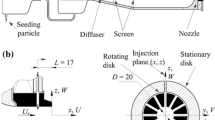Abstract
A precessing jet nozzle with water as the working fluid is investigated under passive and active flow control. The actuation effectiveness of 12 microjets around the nozzle inlet for active control of the precessing jet is the focus of this work. Passive control is also applied by modifying the geometry of the precessing jet either by adding a center body near the chamber exit or varying the chamber length. The flow behavior under control is studied using pressure measurement at the chamber exit plane to monitor jet precession. The pressure data are analyzed using a phase plane representation to determine the motion of the jets high-velocity region in the chamber exit plane. The standard deviation of the phase of the triggered pressure data is used for stability analysis. This analysis results in a phase diagram in terms of Reynolds number and actuation frequency. Active control can be utilized over a range of actuation frequencies (and corresponding Strouhal numbers) to control precession direction and stability which can be further enhanced with passive control mechanisms. However, the flow follows the actuation with the lowest variation when the active actuation matches with the natural Strouhal number \((0.002<St<0.006)\) of the nozzle jet flow.













Similar content being viewed by others
References
Babazadeh H (2010) Active flow control of a precessing jet. M.Sc. thesis, University of Alberta
Babazadeh H, Koch CR, Nobes DS (2011) Investigation of micro-jet active control of a precessing jet using PIV. Exp Fluids 51(6):1709–1719
Green S (ed) (1995) Fluid vortices. Kluwer Academic Publishers, The Netherlands
Guo B, Langrish T, Fletcher D (2001) Numerical simulation of unsteady turbulent flow in axisymmetric sudden expansions. J Fluids Eng 123:574–587
Hill S, Nathan G, Luxton R (1995) Precession in axisymmetric confined jets. In: 12th Australasian fluid mechanics conference
Huerre P, Monkewitz P (1985) Absolute and convective instabilities in free shear layers. J Fluid Mech 159:151–168
Madej A, Babazadeh H, Nobes DS (2011) The effect of chamber length and reynolds number on jet precession. Exp Fluid 51(6):1623–1643
Manias C, Balendra A, Retallack D (1996) New combustion technology for lime production. World Cem 27(12):34–39
Mi J, Nathan G (2004) Self-excited jet-precession strouhal number and its influence on downstream mixing field. J Fluids Struct 19:851–862
Mi J, Nathan G (2005) Statistical analysis of the velocity field in a mechanical precessing jet flow. Phys Fluids 17(015):102–17
Mi J, Nathan G, Wong C (2006) The influence of inlet flow condition on the frequency of self-excited jet precession. J Fluids Struct 22:129–133
Nathan G (1988) The enhanced mixing burner. PhD thesis, University of Adelaide
Nathan G, Hill S, Luxton R (1998) An axisymmetric nozzle to generate jet precession. J Fluid Mech 370:347–380
Nathan G, Mi J, Alwahabi Z, Newbold G, Nobes D (2006) Impacts of a jet’s exit flow pattern on mixing and combustion performance. Prog Energy Combust Sci 32(5–6):496–538
Newbold G (1998) Mixing and combustion in precessing jet flows. PhD thesis, University of Adelaide
Nobes DS (1998) The generation of large-scale structures by jet precession. PhD thesis, University of Adelaide
Schneider G, Ariyur K, Krstic M (2000) Tuning of a combustion controller by extremum seeking: a simulation study. In: Proceedings of the 39th IEEE conference on decision and control 2000, vol 5, pp 5219–5223
Wong C, Lanspeary P, Nathan G, Kelso R, O’Doherty T (2003) Phase-averaged velocity in a fluidic precessing jet nozzle and in its near external field. Exp Therm Fluid Sci 27:515–524
Wong C, Nathan G, O’Doherty T (2004) The effect of initial conditions on the exit flow from a fluidic precessing jet nozzle. Exp Fluids 36:70–81
Acknowledgments
The authors acknowledge funding support for this research from the Alberta Ingenuity Fund, the Natural Sciences and Research Council (NSERC) of Canada, and the Canadian Foundation for Innovation (CFI).
Author information
Authors and Affiliations
Corresponding author
Rights and permissions
About this article
Cite this article
Babazadeh, H., Nobes, D.S. & Koch, C.R. Active and passive flow control on a precessing jet. Exp Fluids 56, 10 (2015). https://doi.org/10.1007/s00348-014-1873-7
Received:
Revised:
Accepted:
Published:
DOI: https://doi.org/10.1007/s00348-014-1873-7




